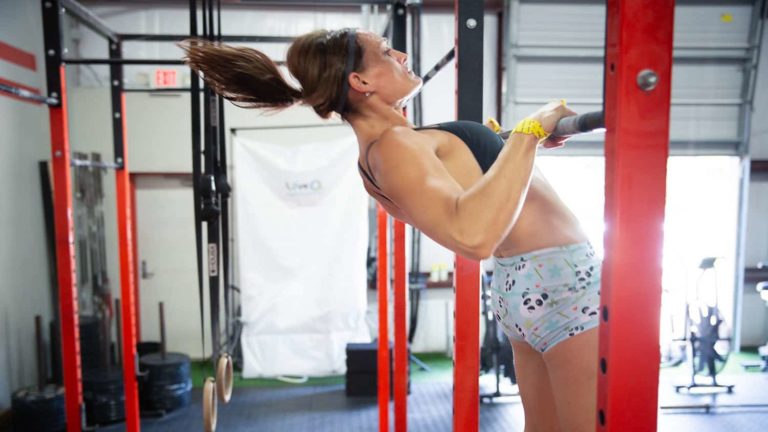This article is the seventh in our series with gymnastics athlete and coach Pamela Gagnon. The first was on kipping pull-ups, the second on toes-to-bar, the third on handstand push-ups, the fourth on bar muscle-ups, the fifth on handstand walking, and the sixth on ring muscle-ups. Now, let’s move on to butterfly pull-ups!
“Not one pull-up was done.” This is the typical response you get when someone watches you do butterfly pull-ups. So, why do butterfly pull-ups get a bad rap, and should you be doing them?
A DEEPER LOOK INTO BUTTERFLY PULL-UPS
 The butterfly pull-up uses global extension and global flexion to create momentum while the athlete pulls up to the bar. The skill can be considered a precursor to the “tap swing” gymnasts use to generate power for their giant swings. The tap swing uses Newton’s Third Law of Physics, in which we can generate power through an equal and opposite reaction.
The butterfly pull-up uses global extension and global flexion to create momentum while the athlete pulls up to the bar. The skill can be considered a precursor to the “tap swing” gymnasts use to generate power for their giant swings. The tap swing uses Newton’s Third Law of Physics, in which we can generate power through an equal and opposite reaction.
The butterfly pull-up allows you to use this theory and apply your pulling strength to generate more work in less time. Hence, the butterfly pull-up was born during a CrossFit competition in 2007. It wasn’t meant to be a standard pull-up variation, but it caught on fast when athletes realized it was the fastest way to go from the hang to the chin over the bar and edge out their competition.
Even if you choose not to do them in workouts, as a CrossFit athlete, it’s valuable to understand the basics of building this skill. In CrossFit, you know skills are built first with mechanics, next with consistency, and finally with intensity. If butterfly pull-ups create the intensity, you must have the mechanics, which include strict strength and the ability to create tension in the arch and hollow, and consistency, which means practicing them outside of class.
ARE THEY FOR ME?
As we know, there are usually two sides to a conversation. So, let’s look at both sides: Team YES for butterfly pull-ups and Team NO for butterfly pull-ups.
TEAM YES:
- They are an efficient way to fulfill the Rx’d standard of chin above the plane of the rig and full lockout at the bottom of the hang.
- They are less taxing muscular-wise than regular or kipping pull-ups.
- They allow you to do more work in less time.
TEAM NO:
- They add too much torque to the shoulders as you come through the bottom of the skill.
- They are not building strength like strict or kipping pull-ups would.
- Many people look like they are flailing around on the rig.
So now that we have looked at both sides of this debate, let’s figure out if this is a pull-up you should be learning, using during a competition, or doing in your gym workouts.
SHOULD I BE LEARNING THIS SKILL?
You are ready to learn this skill if you can do five or more slow and controlled strict pull-ups and can show full control during the descent of each rep. You should also be able to perform, without pain in the shoulders, approximately 30-50 hanging shrugs. These two skills will help you understand if you have the shoulder health and pulling strength to perform butterfly pull-ups safely.
Now that we have established you have the strength and shoulder health necessary, let’s look at what you are trying to accomplish.
If you are trying to compete at a regional or masters level, these will benefit your goals. Kipping pull-ups are slower, and you will have a disadvantage in regional and Games-level competitions.
If you are trying to compete as a scaled athlete in local competitions, these are not necessary to achieve that goal. In this case, the risk usually outweighs the benefits. First, many scaled athletes do not have the volume of strict strength needed as a foundation for butterfly pull-ups, and next, the mechanics can be complicated under intensity.
Practice
Success in the gymnastics portion of CrossFit requires regular practice, not just attempts during the workout. Therefore, doing drills and warm-ups outside of class will help you feel even more prepared the next time pull-ups appear in the workout.
Do these movements three times a week for the next three weeks.
Day 1
6 rounds, 3 rounds of each skill below, of 30 seconds of work/30 seconds of rest:
- Strict pull-ups (either wide grip or behind the neck)
- Arch hollow snap drill
Day 2
Accumulate 2 minutes of practice:
Day 3
3 rounds, 1 minute of work and 1 minute of rest between sets:
- Practice butterfly pull-ups
Drills and Warm-Ups
A few quality drills and warm-ups include:
- Face Pull Y Press
- PVC Prone Lifts
- Behind the Neck Pull Ups
- Strict Butterfly Circles
- Standing Banded Arch Hollows
So, what do you think? Are butterfly pull-ups for you?
About the Author

Pamela Gagnon is the co-creator of Performance Plus Programming and can help you get your first ring muscle-up in less than five weeks. She is a four-time Masters CrossFit Games athlete and a former D1 Gymnast. As a CF-L2, she was a lead coach for eight years with the CrossFit Gymnastics Course. She also currently writes gymnastics programming for CrossFit Mayhem.
Butterfly Pull-Ups: Should You Add Them to Your Training?